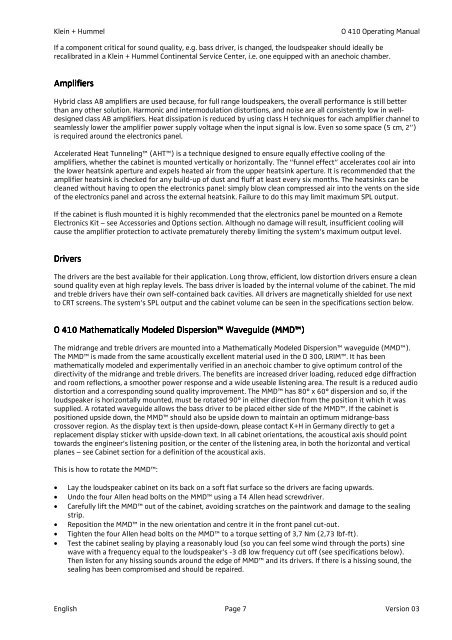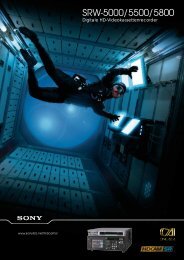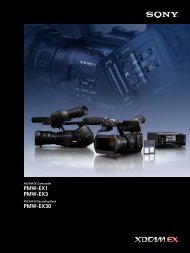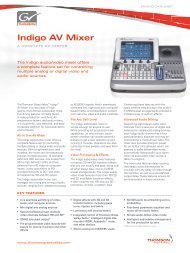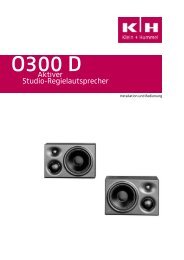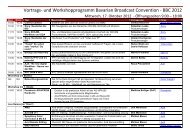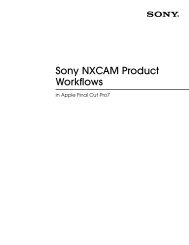O 410 Operating Manual v03 - Videocation
O 410 Operating Manual v03 - Videocation
O 410 Operating Manual v03 - Videocation
Create successful ePaper yourself
Turn your PDF publications into a flip-book with our unique Google optimized e-Paper software.
Klein + Hummel O <strong>410</strong> <strong>Operating</strong> <strong>Manual</strong><br />
If a component critical for sound quality, e.g. bass driver, is changed, the loudspeaker should ideally be<br />
recalibrated in a Klein + Hummel Continental Service Center, i.e. one equipped with an anechoic chamber.<br />
Amplifiers<br />
Amplifiers<br />
Hybrid class AB amplifiers are used because, for full range loudspeakers, the overall performance is still better<br />
than any other solution. Harmonic and intermodulation distortions, and noise are all consistently low in welldesigned<br />
class AB amplifiers. Heat dissipation is reduced by using class H techniques for each amplifier channel to<br />
seamlessly lower the amplifier power supply voltage when the input signal is low. Even so some space (5 cm, 2”)<br />
is required around the electronics panel.<br />
Accelerated Heat Tunneling (AHT) is a technique designed to ensure equally effective cooling of the<br />
amplifiers, whether the cabinet is mounted vertically or horizontally. The “funnel effect” accelerates cool air into<br />
the lower heatsink aperture and expels heated air from the upper heatsink aperture. It is recommended that the<br />
amplifier heatsink is checked for any build-up of dust and fluff at least every six months. The heatsinks can be<br />
cleaned without having to open the electronics panel: simply blow clean compressed air into the vents on the side<br />
of the electronics panel and across the external heatsink. Failure to do this may limit maximum SPL output.<br />
If the cabinet is flush mounted it is highly recommended that the electronics panel be mounted on a Remote<br />
Electronics Kit – see Accessories and Options section. Although no damage will result, insufficient cooling will<br />
cause the amplifier protection to activate prematurely thereby limiting the system’s maximum output level.<br />
Drivers Drivers<br />
Drivers<br />
The drivers are the best available for their application. Long throw, efficient, low distortion drivers ensure a clean<br />
sound quality even at high replay levels. The bass driver is loaded by the internal volume of the cabinet. The mid<br />
and treble drivers have their own self-contained back cavities. All drivers are magnetically shielded for use next<br />
to CRT screens. The system’s SPL output and the cabinet volume can be seen in the specifications section below.<br />
O O <strong>410</strong> <strong>410</strong> <strong>410</strong> Mathematically Mathematically Modeled Modeled Dispersion Dispersion Waveguide Waveguide (MMD) (MMD) (MMD)<br />
The midrange and treble drivers are mounted into a Mathematically Modeled Dispersion waveguide (MMD).<br />
The MMD is made from the same acoustically excellent material used in the O 300, LRIM. It has been<br />
mathematically modeled and experimentally verified in an anechoic chamber to give optimum control of the<br />
directivity of the midrange and treble drivers. The benefits are increased driver loading, reduced edge diffraction<br />
and room reflections, a smoother power response and a wide useable listening area. The result is a reduced audio<br />
distortion and a corresponding sound quality improvement. The MMD has 80° x 60° dispersion and so, if the<br />
loudspeaker is horizontally mounted, must be rotated 90° in either direction from the position it which it was<br />
supplied. A rotated waveguide allows the bass driver to be placed either side of the MMD. If the cabinet is<br />
positioned upside down, the MMD should also be upside down to maintain an optimum midrange-bass<br />
crossover region. As the display text is then upside-down, please contact K+H in Germany directly to get a<br />
replacement display sticker with upside-down text. In all cabinet orientations, the acoustical axis should point<br />
towards the engineer’s listening position, or the center of the listening area, in both the horizontal and vertical<br />
planes – see Cabinet section for a definition of the acoustical axis.<br />
This is how to rotate the MMD:<br />
• Lay the loudspeaker cabinet on its back on a soft flat surface so the drivers are facing upwards.<br />
• Undo the four Allen head bolts on the MMD using a T4 Allen head screwdriver.<br />
• Carefully lift the MMD out of the cabinet, avoiding scratches on the paintwork and damage to the sealing<br />
strip.<br />
• Reposition the MMD in the new orientation and centre it in the front panel cut-out.<br />
• Tighten the four Allen head bolts on the MMD to a torque setting of 3,7 Nm (2,73 lbf-ft).<br />
• Test the cabinet sealing by playing a reasonably loud (so you can feel some wind through the ports) sine<br />
wave with a frequency equal to the loudspeaker’s -3 dB low frequency cut off (see specifications below).<br />
Then listen for any hissing sounds around the edge of MMD and its drivers. If there is a hissing sound, the<br />
sealing has been compromised and should be repaired.<br />
English Page 7 Version 03


